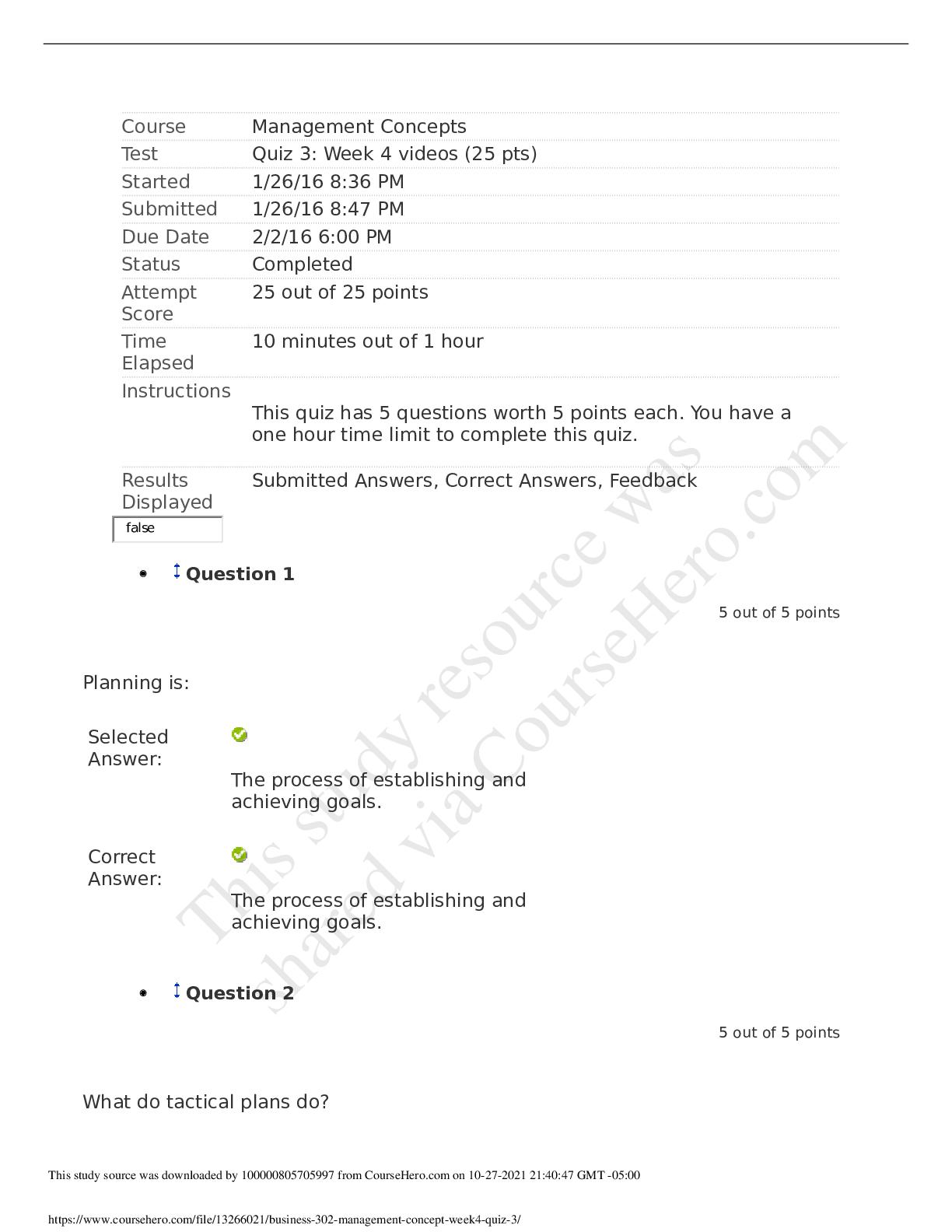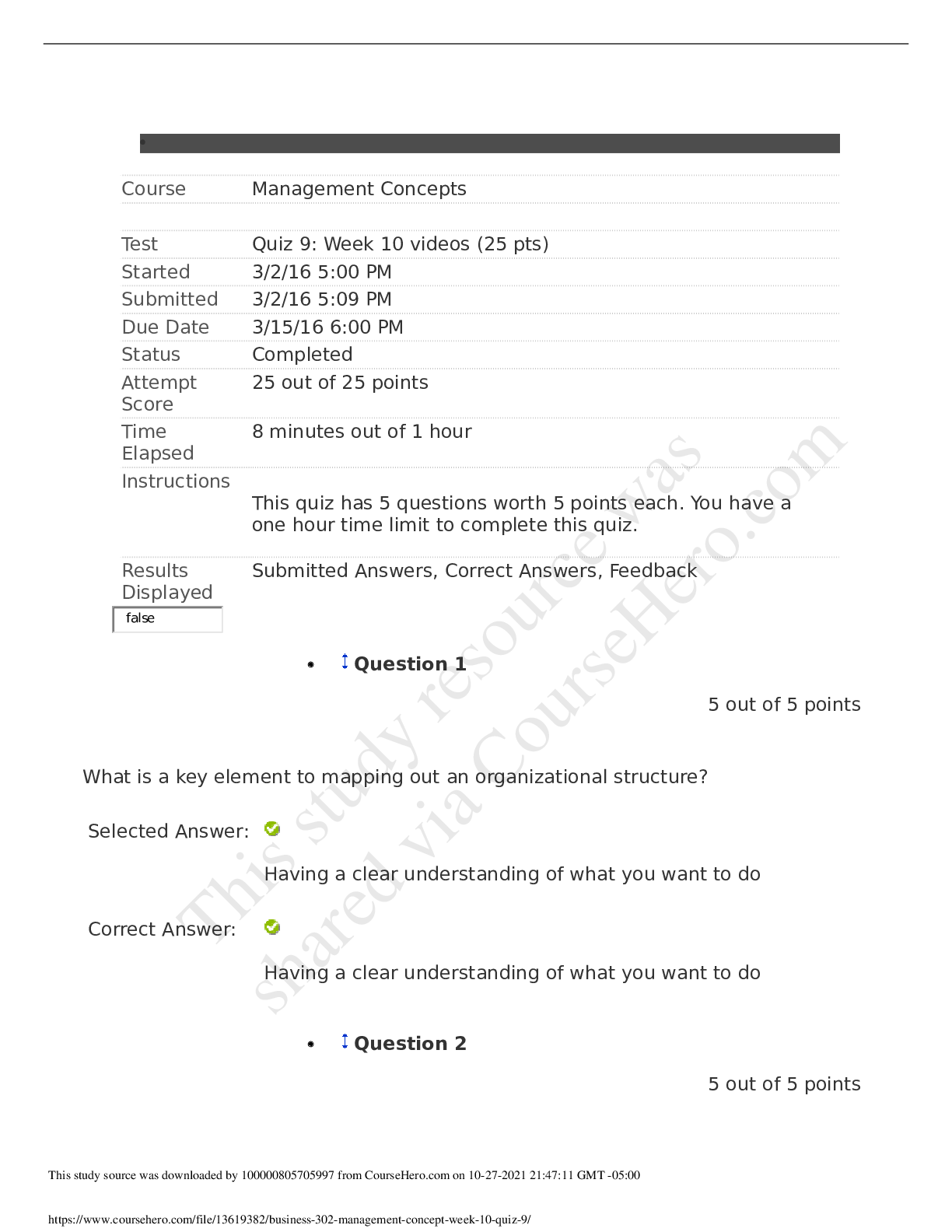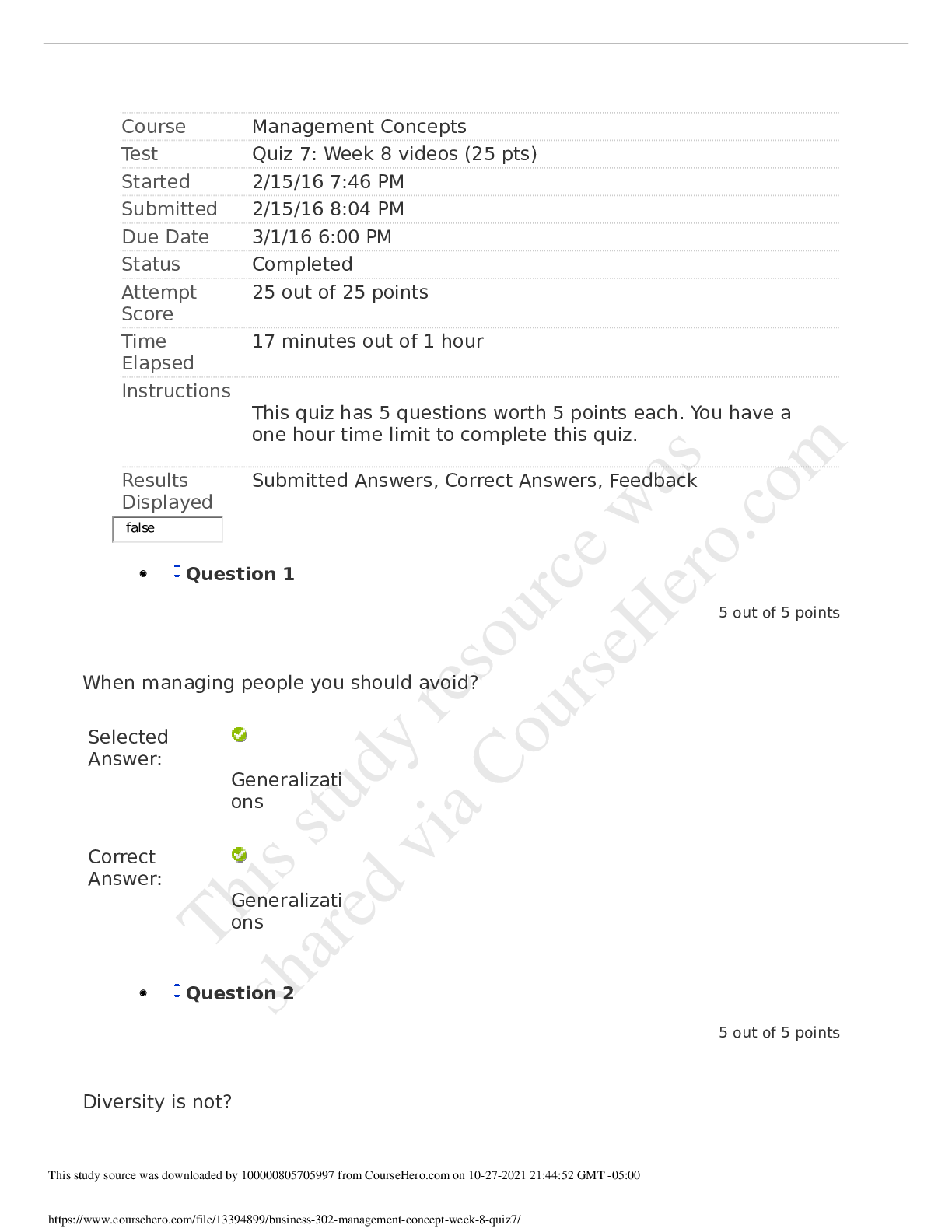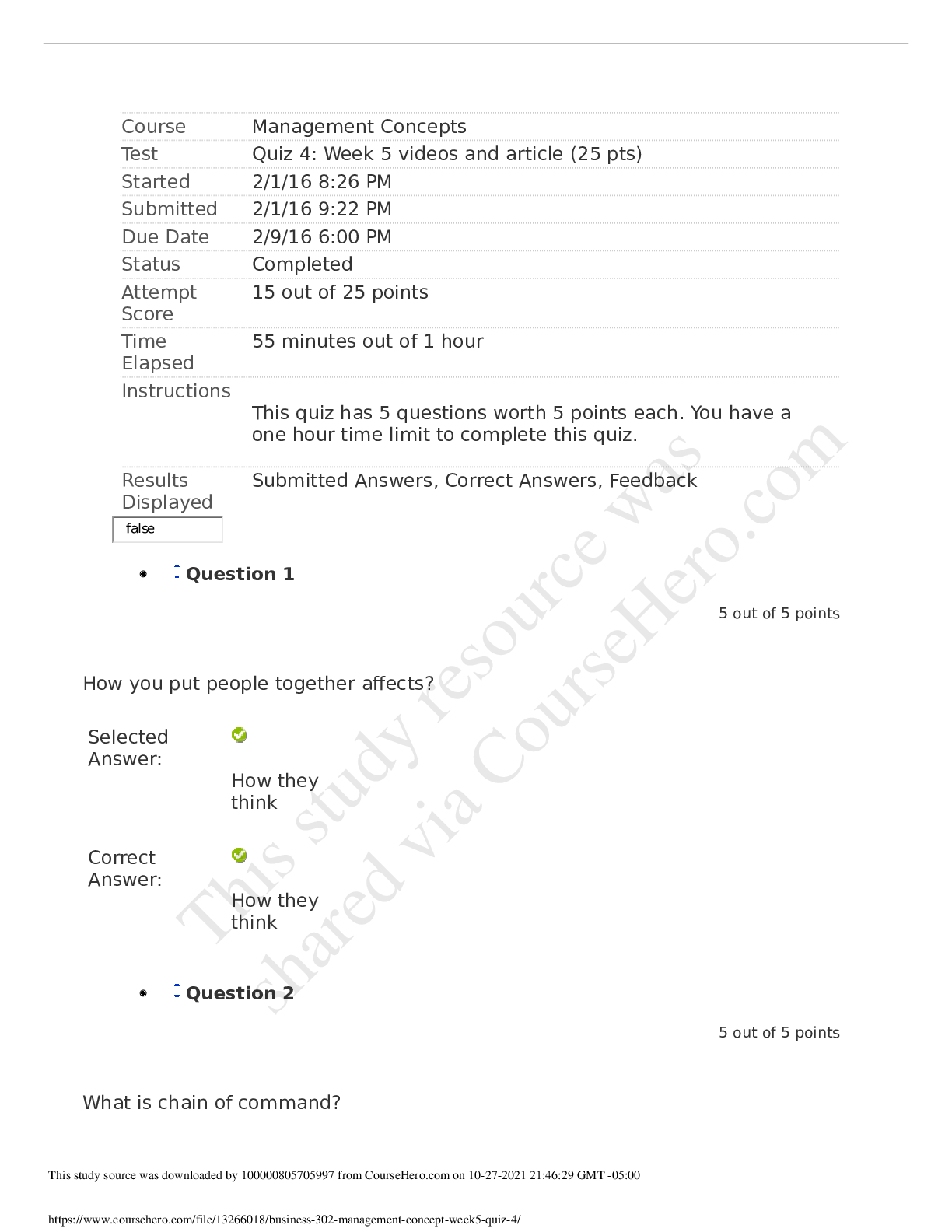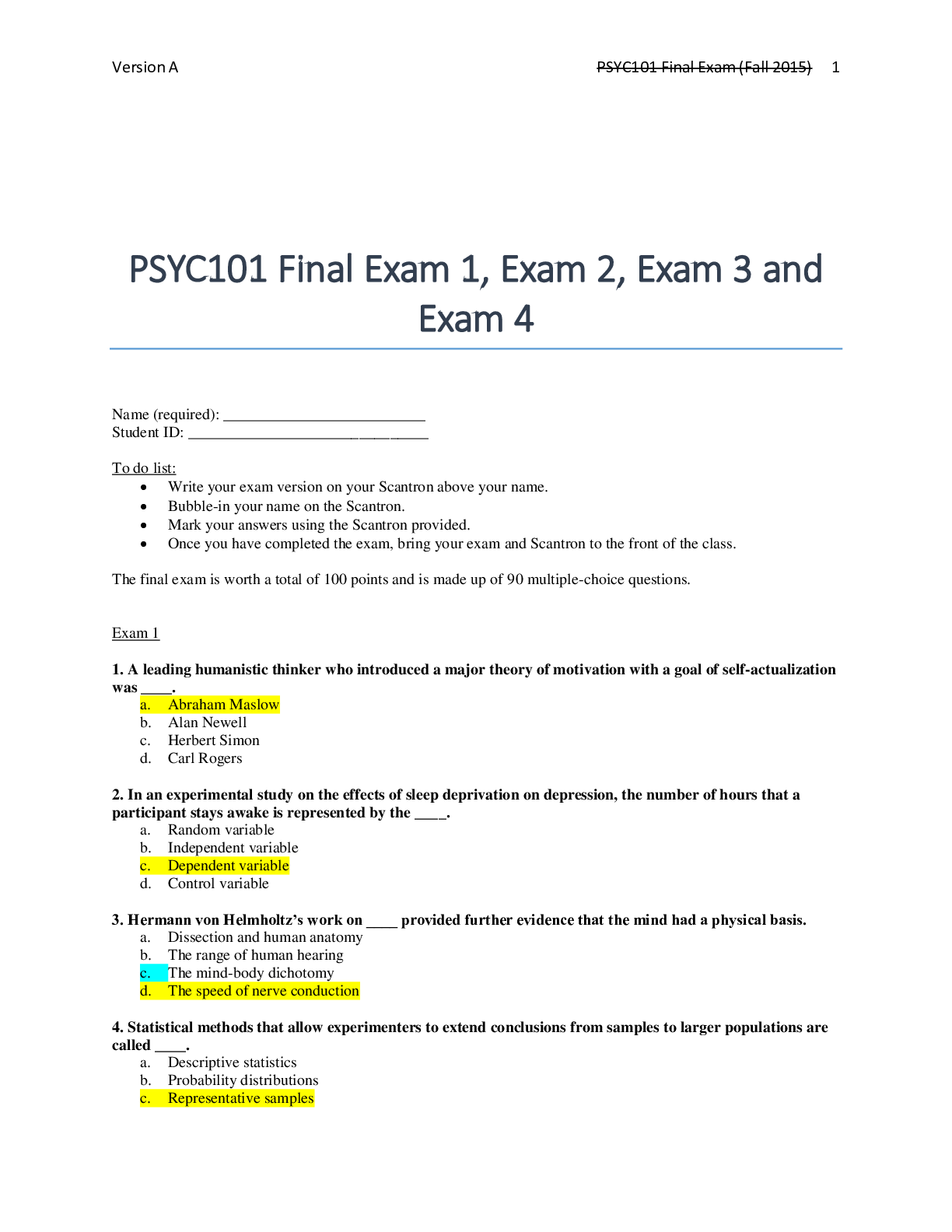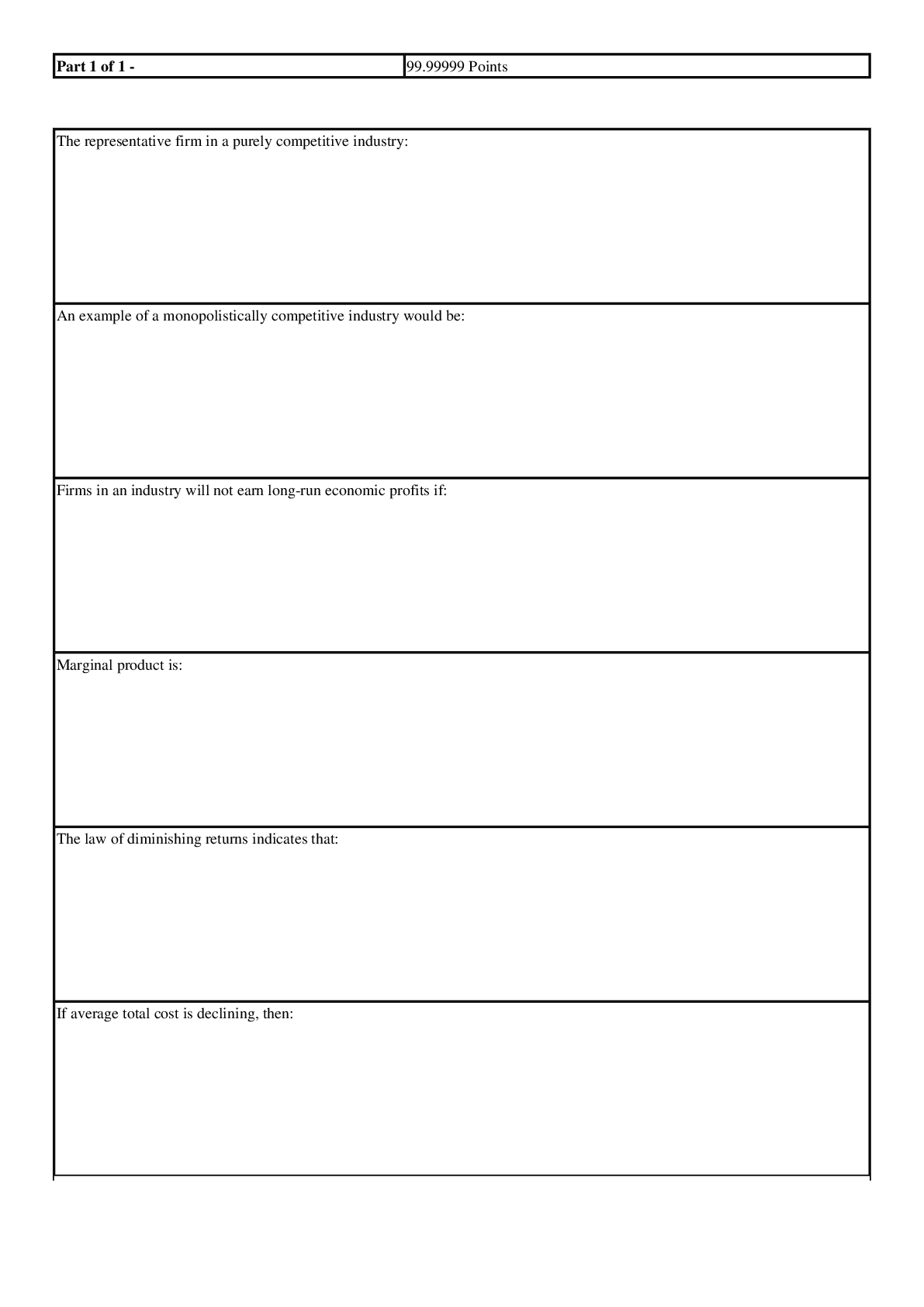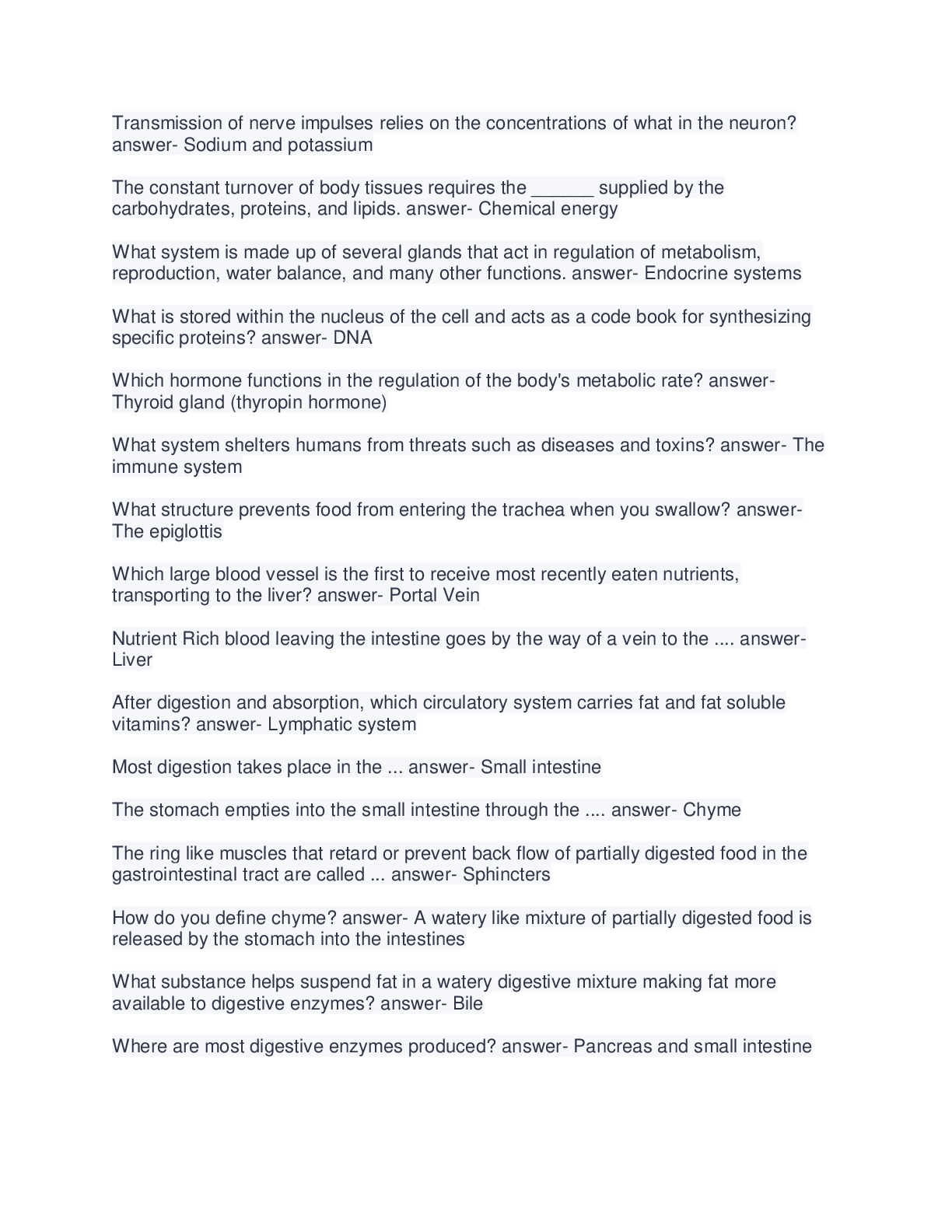Business > QUESTIONS & ANSWERS > [Solved] University of Pennsylvania BIO 101 Final Exam Bio101 Final Exam Key (All)
[Solved] University of Pennsylvania BIO 101 Final Exam Bio101 Final Exam Key
Document Content and Description Below
University of Pennsylvania - BIO 101Bio 101 Final Exam Key I. True and False (15 points total): Read the following statement carefully and determine if they are true or false (0.5 point). If fals... e, underline the false part and correct with a minimum amount of change to the statement (1 point). (It is not sufficient to simply negate the statement as in the following: the sky is green --> the sky is not green). 1. ----F---- Photosynthesis occurs only in plants, algae and protists, but not/ and also in prokaryotes, and this process produces O2 from CO2/H2O. 2. ----T--- Transcriptional response elements are specific DNA sequences that are found in eukaryotic enhancer regions, and they bind specific transcription factors in response to specific signals (e.g., heavy metals or high temperature). 3. ----T---- snRNAs contain phosphodiester bonds, whereas triglycerides contain ester bonds in their chemical structures. 4. ----F---- Polysaccharides and polypeptides are synthesized by polymerization of their respective monomers via hydrolysis/dehydration reactions. 5. ---T----- In the Calvin cycle, the ribulose-bisphosphate carboxylase is the only enzyme that uses CO2 to convert ribulose bisphosphate to a short-lived intermediate, which decomposes spontaneously to 2 molecules of phosphoglycerate. 6. ---F----- At a given concentration of substrate, an inhibitor of an allosteric enzyme binds to the active site/ allosteric (or a site different than the active site) site of the enzyme, and increases/decreases the rate of product formation. 7. ----T---- NADH dehydrogenase, cytochrome bc complex and cytochrome c oxidase are three respiratory complexes that are responsible for proton translocation across the membrane. 8. ----F---- In the absence of oxygen, pyruvate could be further converted to ethanol and CO2, to regenerate FADH2/NAD+ and yield ATP via the citric acid cycle/fermentation. 9. ----T---- During DNA replication, the helicase and topoisomerase unwind the double stranded DNA, the ssb proteins keep the single strands separated, and the primase synthesizes a short RNA to provide a 3’ OH to the DNA pol III for elongation. 10. ----F---- Both inducible and repressible operons are positively/negatively regulated, because the gene expression is switched off by binding of the active form of the repressors to their promoter/operator sites on the DNA. II. (5 points, 1 points each) Circle the best answer (only one answer per question): 1. Which of the following components is never found in the nucleus of a eukaryotic cell a. tRNA b. mRNA c. nucleolus d. Okazaki fragments e. release factor 2. The targeting of a protein into specific organelles is mediated by a. membrane ion channel receptors b. the aminoacid sequence of the protein c. alternate splicing and polyadenylation of its mRNA d. its three dimensional conformation and disulfide bonds e. the 5’- and 3’-UTR sequences of its corresponding gene 3. During translation of a mRNA to a polypeptide energy is provided by hydrolysis of a. ATP and GTP b. ADP and GDP c. ATP and PEP d. ADP and GTP e. PEP and GTP 4. Which of the following proteins is synthesized at specific times during the cell cycle, and it associates with a kinase to form complex important for mitosis? a. histone b. ubiquitin c. cyclin d. keratin e. lamin 5. Which of the following cell components is mismatched with one of its functions? a. Peroxisomes ----> degradation of fats b. Mitochondria ----> H2O production c. Nucleolus ----> ribosome synthesis d. Kinetochore ---> chromosome attachment e. None of the above III. (5 points, 0.5 per line). For each of the molecules below, indicate which major process it is involved in [DNA replication (A); RNA transcription (B); or protein translation (C)] and . III. (5 points, 0.5 per line). For each of the molecules below, indicate which major process it is involved in [DNA replication (A); RNA transcription (B); or protein translation (C)] and whether they are found in Prokaryotes (PR) only, in Eukaryotes only (EU), or in both organisms (BO) IV. (6 points total, 1 point per line). Match features A through H with the processes listed below. For each process, list two letters that apply. Some letters may be used multiple times and some letters may not be used at all. V. (13 points total). Arabinose is a sugar commonly found in nature. Bacteria like E. coli can metabolize arabinose using a set of genes, araB, araA and araD that are organized together as an operon (araBAD), and transcribed in this order. A fourth gene, araC, is located outside of the araBAD operon, and codes for a protein that is suspected to regulate expression of the araBAD operon in response to arabinose availability. a- How many different mRNAs are produced from the araBAD operon? Which ara gene is close to the 5’-P (5’-phosphate), and which ara gene is close to the 3’-OH (3’-hydroxyl) ends (2 points). b- How many kinds of proteins are produced from the araBAD operon, and how many ribosome binding (Shine-Delgaro) sites are present on the araBAD mRNA? (2 points) c- To determine whether araC is a regulator of the araBAD operon, you have isolated a mutant in which araC gene is deleted. You measured the amounts of the araBAD gene products in this araC deletion mutant in the presence and absence of arabinose, and compared the data obtained to a strain that contains an intact araC gene. You obtained the following results: Based on the data above, is araC a positive or a negative regulator? Assuming that, like any regulator, AraC protein also binds DNA, do you suspect that it binds near the 5’ or the 3’ end of araBAD operon? (3 points)? d- Consider an araC missense mutant that produces a mutant form of AraC protein that is unable to bind arabinose. In this mutant, would the amounts of araBAD gene products be high or low in the presence of arabinose, and why (3 points)? e- After hard work, you show that in the presence of arabinose, AraC binds to a DNA sequence several hundred basepairs 5’ upstream of the RNA polymerase binding site of the araBAD operon, in a way similar to the regulatory regions of eukaryotic genes. What would be an additional protein necessary for regulating the bacterial araBAD operon by araC (3 points)? VI. (6 points). In humans, phosphofructokinase deficiency leads to GSD or glycogen storage disorder (Tarui disease). During a gene therapy attempt, you discovered that the bacterial phosphofructokinase gene produces an active protein when introduced into the human cells; however, the human phosphofructokinase gene does not yield any protein when introduced into the bacterial cells. Further investigations indicated that the human gene is transcribed, and the corresponding mRNA in bacteria was longer than the same mRNA found in the cytoplasm of human cells. In fact the bacteria-produced human mRNAwas identical in length to the corresponding pre-mRNA in human cells. a- Why do you think that bacteria do not produce the human phoshofructokinase protein even though they transcribe the corresponding human gene? (3 points) b- Considering that you can obtain from the cytoplasm of human cells mature mRNA of correct size for human phosphopructokinase, how would you clone this mRNA into a plasmid to produce this protein in bacteria? (3 points) 1. As you know, epiphytic plants are common in tropical areas. In areas where the humidity is low and/or there is a distinct dry season, many epiphytic plants are succulent and use the CAM photosynthetic pathway. These traits are less common in epiphytes where humidity is higher. In two or three sentences, provide an explanation for why CAM photosynthesis would be advantageous in epiphytes under more arid conditions. 2. a. Where in the fern life cycle does meiosis occur? That is, what is the immediate product of meiosis in ferns (or any other plant)? (2 points) b. Suppose a hypothetical fern sporophyte was heterozygous at a particular locus (i.e. Hh). If this fern species is homosporous and eggs are all fertilized by sperm produced on the same gametophyte, what will be the genotype(s) at the H locus for the next generation of adult sporophytes? Circle all that apply: (2 points) c. If this fern species were heterosporous instead, what would be the possible genotype(s) of the next generation of fern sporophytes? Circle all that apply: (2 points) VIII. Matching 3. The following list describes parts of the angiosperm and gymnosperm life cycles. Match the descriptions with the words from the list by placing the correct letter(s) in each blank. There may be more than one correct answer per blank. (2 points each) a. embryo sacs b. megagametophyte with archegonia c. adult pine trees d. pollen grains e. microspores e. stigma and style IX 4. How is it possible that a man and a woman, who are both fairly short, have a child who grows up to be quite tall? Circle the letter corresponding to the single best answer. (2 points) a. Human height is controlled by a X-linked gene b. Human height is a polygenic trait c. Alleles coding for tall height are dominant d. This results from alternation of generations e. Spontaneous mutations are responsible 5a. If two pea plants that heterozygous at two loci are crossed (RrYy X RrYy), and these genes are on different chromosomes, what proportion of the offspring that are homozygous dominant at the R locus will also be homozygous dominant at the Y locus? (2 points) b. When in meiosis does random assortment of chromosomes occur? (2 points) 6. As emphasized in Dr. Gallagher’s lecture, most plants retain the ability to develop and change their form throughout their lifespan—something most animals cannot do. This ability to change form is due, in part, to the plant’s active meristems. We know that plants can also change form in response to particular environmental signals, such as light or gravity, in processes that don’t involve meristems. (3 points total) a. Does phototropism involve cell level changes in stems, leaves or flowers? (list one of these three). stems b. Does phototropism involve new cell division or cell expansion? (list one) c. What hormone is responsible for changes at the cellular level in phototropism? X. TRUE/FALSE Please write the entire word in the space provided. (2 points each) 7a. ____A single plant is likely to transpire at different rates in early morning compared to mid-day even if its stomata are open to the same degree. 7b. ____All of the water that is gathered by the roots and transpired from the leaves must pass through the endodermis. 7c. ____The high positive pressure in the phloem requires that sieve tubes have strong secondary cell walls. 7d. _____Carbohydrates are transported in the phloem in the form of glucose. 7e. _____Hemi-parasites, such as mistletoes, rely on connections to their host’s phloem to meet their high demands for sugars. XI. Short Answer 8. Some well-preserved, small plant parts were found on an archeological dig. The archeologist wasn’t sure if they were portions of stems or portions of roots and brought them to you for help identifying them. a. What surface characters would tell you whether they were roots or stems? (2 points) b. If you had the ability to examine the vascular structure under a microscope, how would the location of the vascular tissue help you distinguish roots from stems? (2 points) 9. Human sex-linked traits are frequently expressed even if recessive. Think about this in answering the following questions. a. Are these traits more commonly expressed in men or women? (2 points) b. What is a carrier of a sex-linked trait? That is, what is the sex and genotype (at this locus) of a carrier? (2 points) 10. The dispersal units plants use to colonize new habitats over long distances in space or to remain dormant over time differ among major plant groups. a. What structure enables angiosperms to colonize new habitats or remain dormant for long periods of time? (2 points) b. Gymnosperms are naked-seeded, while angiosperms are not. What difference does this make for the path of pollen tube growth in angiosperms compared to gymnosperms? (2 points) 11. Why are plants green? That is, what photoreceptor is responsible, and why do leaves appear green and not blue or red or yellow? (2 points) [Show More]
Last updated: 1 year ago
Preview 1 out of 15 pages
Instant download

Buy this document to get the full access instantly
Instant Download Access after purchase
Add to cartInstant download
Reviews( 0 )
Document information
Connected school, study & course
About the document
Uploaded On
Dec 18, 2020
Number of pages
15
Written in
Additional information
This document has been written for:
Uploaded
Dec 18, 2020
Downloads
0
Views
38

